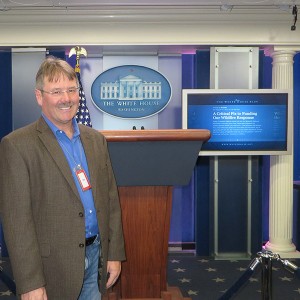
ESPM professor and fire scientist Scott Stephens visited the White House earlier this week as a speaker in the Fire Chiefs White House Roundtable on Climate Change Impacts at the Wildland Urban Interface. Hosted by Vice President Joe Biden, the roundtable focused on how climate change is impacting the number, frequency, and intensity of wildfires in the U.S., and how we can better manage the wildland/urban interface going forward. We caught professor Stephens in the halls of Mulford to hear a bit more about the visit:
Q1. What were some of the key discussion points at the roundtable?
The goal of the meeting was to see if actions could be taken to reduce human losses in the wildland/urban interface using existing dollars, and to discuss how climate change is impacting this area. It was clear from FEMA Administrator Craig Fugate that with flat budgets for the remainder of the Obama Administration, no new dollars will be available. The idea was to see if existing dollars could be allocated better to address this issue. Ideas were presented and many questions and comments were discussed.
Q2. What do you think is the single most important thing the U.S. should change in its management of the wildland/urban interface?
I believe the main issues in the Interface are social. At the meeting, I spoke about my work with Australian scientists and how they do a much better job of engaging the people who live in the Interface with the problems and solutions there. They do this with Community Fire Brigades that ask people in neighborhoods to meet at a central point in neighborhoods to talk about what they are doing to prepare for fires, who will evacuate early if a fire comes, what routes to take to evacuate, and how to prepare homes to survive fire. This is something we should do in the U.S.
Q3. Vice President Joe Biden was host of the roundtable. What did he have to say on the issue? And, what was he like?
Vice President Joe Biden arrived with a speech in his hand that his staff had written. He said it was a ‘really good speech,’ but then set it aside saying ‘I have a bit of a reputation of not keeping on point regarding speeches.’ Biden spoke for 15 minutes, and I was impressed at how well he understood the issues related to fire and climate change. He also thanked the fire chiefs in the room a great deal for their work; you could tell he had a great relationship with this group. After hearing him talk I thought it was too bad that he was not running for President. We only saw him for a few minutes, but he made a very positive impression on the whole group.
Q4. What was the coolest thing about going to the White House?
My wife Mary and I were given a great tour of the west wing and saw the Oval Office, Cabinet Room, Press Room, and others. All of the rooms look bigger on TV! The Oval Office was great, and our tour guide had a fantastic background on White House history. The secret service agent in front of the Oval Office was a forestry/history student in college. One cool thing: the walls of many rooms in the White House have 2 x 3 foot color prints of pictures taken when the President does his normal duties. These are changed out every 2 weeks or so. It was nice to see pictures of the President with both average citizens and with the Pope!
Read an official statement from the White House on the meeting.
Professor Stephens has also commented on forest management in these and other recent news stories.
“Managing Wildfires Requires New Strategies” – Public Policy Institute of California
“California Fires Update” – KQED Forum
“Feel the Burn: To Avoid Year-Round Wildfires, California Needs to Up Its Forestry Game” – California Magazine
